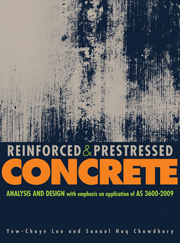Book contents
- Frontmatter
- Contents
- Preface
- Acknowledgements
- Notation
- Acknowledgements for tables and diagrams
- Acronyms and abbreviations
- Part I Reinforced concrete
- Part II Prestressed concrete
- 12 Introduction to prestressed concrete
- 13 Critical stress state analysis of beams
- 14 Critical stress state design of beams
- 15 Ultimate strength analysis of beams
- 16 End blocks for prestressing anchorages
- Appendix A Elastic neutral axis
- Appendix B Critical shear perimeter
- Appendix C Development of an integrated package for design of reinforced concrete flat plates on personal computer
- Appendix D Strut-and-tie modelling of concrete structures
- Appendix E Australian Standard precast prestressed concrete bridge girder sections
- References
- Index
12 - Introduction to prestressed concrete
from Part II - Prestressed concrete
- Frontmatter
- Contents
- Preface
- Acknowledgements
- Notation
- Acknowledgements for tables and diagrams
- Acronyms and abbreviations
- Part I Reinforced concrete
- Part II Prestressed concrete
- 12 Introduction to prestressed concrete
- 13 Critical stress state analysis of beams
- 14 Critical stress state design of beams
- 15 Ultimate strength analysis of beams
- 16 End blocks for prestressing anchorages
- Appendix A Elastic neutral axis
- Appendix B Critical shear perimeter
- Appendix C Development of an integrated package for design of reinforced concrete flat plates on personal computer
- Appendix D Strut-and-tie modelling of concrete structures
- Appendix E Australian Standard precast prestressed concrete bridge girder sections
- References
- Index
Summary
General remarks
Prestressing may be seen as an elaborate and active way to reinforce the weakness of concrete in tension. Whereas the traditional reinforcement becomes active mainly after the concrete has exceeded its cracking strength, the purpose of prestressing is to prevent cracking from occurring. This is done by introducing compressive stress in the concrete to neutralise the anticipated tensile stress developed under load.
In a traditional reinforced concrete design, the safety margin can always be increased by providing more reinforcement. The same may not be true in prestressed concrete, as over-prestress can cause cracking or perhaps failure before even any external loading is applied. As a result, prestressed concrete analysis and designing is more complicated and mechanics-based than for reinforced concrete, which relies more on empirical formulas. In practice, prestressed concrete also requires a higher level of technology in its construction.
By nature, prestressing is more efficient than the traditional reinforcement in that the stress in concrete, either tensile or compressive (caused by self-weight or other forms of dead load) can be neutralised before any additional (live) loading is applied. Consequently, for a given design, the maximum permissible prestressed concrete span can be considerably larger than a reinforced one. Following some fundamentals given in this chapter, Chapter 13 presents the bending theory of fully prestressed concrete beams based on the critical stress state criteria (which ensures that no cracking or overstressing in tension or compression would ever occur throughout the life of the beam under service load).
- Type
- Chapter
- Information
- Reinforced and Prestressed ConcreteAnalysis and Design with Emphasis on Application of AS3600-2009, pp. 319 - 328Publisher: Cambridge University PressPrint publication year: 2010



